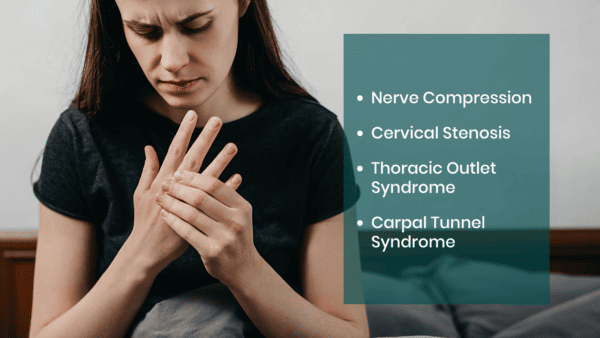What Causes Numbness In Hands While Sleeping?
Jump links: Nerve Compression | Cervical Stenosis | Thoracic Outlet Syndrome | Carpal Tunnel Syndrome
I have heard patients tell me for more than 25 years that their hands go numb at night when they lie down to go to sleep. The sensation of numbness in your hands and fingers (paresthesia) might be unsettling, but should it be something that worries you?
Some people may wake up with numbness or tingling in the hands (pins and needles sensations) once in a while following a sleeping position that cuts off blood flow to nerves in the hands. But consistent pain and numbness in the hands and fingers may indicate a more serious health condition like a disc bulge or carpal tunnel syndrome.

Yurii Yarema/ Shutterstock
Nerve Compression or Peripheral Neuropathy
When any body part goes numb, it usually means that the nerve supply to that area has been cut off. So your arms, hands or fingers going numb while you lie down on your back or side to sleep could be a sign of a compressed nerve that goes from your neck to your hand (peripheral neuropathy).
There are two main types of nerve compression that cause tingling and numbness in the hands or fingers: ulnar nerve compression and median nerve impingement. The ulnar nerve runs from your shoulder to your hand on the inside of your elbow and controls the forearm, ring finger, and pinky finger. The median nerve gives sensation to the thumb, index and middle fingers, and half of the ring finger. It also gives strength to the hand and the muscles next to the base of the thumb.
Nerves have their own blood supply, so pressure on a nerve cuts off that blood supply, and the nerve starves for oxygen and nutrients, making it shut down. If this happens for a short period of time, the nerve wakes up again once the pressure is removed.
Other Causes of Numbness in Hands While Sleeping
Continued or repeated pressure to the nerve can damage it. So months or years of numb hands at night can mean damaged nerves. The following are other possible causes of why hands go numb when you lie down:
Cervical Stenosis
The biggest and most significant cause is neck (cervical) stenosis, which occurs when the opening in the middle of the vertebrae (spinal canal) is too tight and there isn’t enough room for the spinal cord and nerves to pass through (1). Since this wiring is supposed to travel from your brain to your fingers (and back), pressure on the spinal cord here can cause all sorts of problems.
When the neck gets into an awkward position at night, the muscles that protect it during the day relax, the nerves get crunched, and the hands go numb. You may not have constant neck pain with cervical stenosis or a disc bulge. Some patients only notice that their arms and hands are numb.
Many times, a cervical collar worn only at night can help reduce hand numbness. You may need to experiment with different collars or varying amounts of tightness. Usually, wearing it loosely while sitting on the side of the bed is enough, as the shoulders come up when you sleep, and this makes the collar tighter. If this helps your hands, you likely need a cervical MRI to investigate the root cause.
Thoracic Outlet Syndrome (TOS)
The second most common cause is thoracic outlet syndrome. In this case, the nerves near the shoulder get crunched (2). It is a common problem for modern computer users, as the shoulders and head come forward, resulting in nerve compression.
You can find stretches for this issue in our e-book Orthopedics 2.0.
Carpal Tunnel Syndrome
Another cause is carpal tunnel syndrome in the wrists. This occurs when the main nerve of the hand (median nerve) is pinched in the tunnel it travels in the wrist. Symptoms of carpal tunnel syndrome include decreased grip strength or pain, numbness, burning, tingling, or swelling in one or both hands.
Wearing wrist splints at night can greatly help if this is the cause.
However, you may need your doctor to look more closely at the overarching cause of the problem and find the right treatment for you.
Possible Complications
Another reason to be vigilant about getting this figured out is that these nerves being “offline” can lead to nerve damage or other medical conditions, like issues in the upper extremities that are caused by the nightly nerve compression. These include:
Tennis and golfer’s elbow (lateral and medial epicondylitis)
Arthritis in the hands
Arthritis in the shoulder (4)
Rotator cuff injury (5)
When to Talk to Your Doctor About Tingling or Numbness In The Hands That Doesn’t Go Away
The feeling of numbness in your hands when lying down can be very distressing and a sign of a bigger problem. If you notice changes in the overall sensations in your hands, shoulders, elbows, or wrists like tingling or nerve pain and numbness that doesn’t go away after getting out of bed, take it seriously and talk to your doctor.
Keep in mind, though, that physicians who aren’t musculoskeletal experts may not always catch the true root cause of the problem. That’s why it’s essential to look for a medical professional with true musculoskeletal expertise.
Depending on the root cause of the problem, you may be a good candidate for treatments like PRP or BMC injections for carpal tunnel syndrome, which don’t have the side effects of steroid injections and may help you avoid surgery altogether.
__________________________________________________
References
(1) Raja A, Hoang S, Patel P, et al. Spinal Stenosis. [Updated June 12, 2023]. In: StatPearls [Internet]. Treasure Island (FL): StatPearls Publishing; 2021 Jan-.
(2) Jones MR, Prabhakar A, Viswanath O, et al. Thoracic Outlet Syndrome: A Comprehensive Review of Pathophysiology, Diagnosis, and Treatment. Pain Ther. 2019;8(1):5-18. doi:10.1007/s40122-019-0124-2
(3) U.S. Department of Health and Human Services. National Institute of Health. Carpal Tunnel Syndrome. Accessed Oct.18, 2023
(4) Chiarotto A, Fernandez-de-Las-Peñas C, Castaldo M, Negrini S, Villafañe JH. Widespread pressure pain hypersensitivity in elderly subjects with unilateral thumb carpometacarpal osteoarthritis. Hand (N Y). 2013;8(4):422-429. doi:10.1007/s11552-013-9537-2
(5) Dunn CJ, Kurowicki J, Changoor S, et al. Cervical Spinal Stenosis with Coexisting Rotator Cuff Tear: A Nationwide Review of Records from 2005 to 2014. J Long Term Eff Med Implants. 2019;29(3):209-214. doi:10.1615/JLongTermEffMedImplants.2020033315
Originally published on

NOTE: This blog post provides general information to help the reader better understand regenerative medicine, musculoskeletal health, and related subjects. All content provided in this blog, website, or any linked materials, including text, graphics, images, patient profiles, outcomes, and information, are not intended and should not be considered or used as a substitute for medical advice, diagnosis, or treatment. Please always consult with a professional and certified healthcare provider to discuss if a treatment is right for you.
